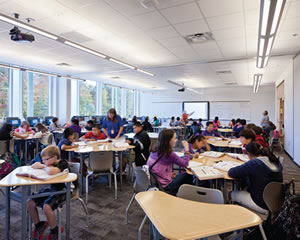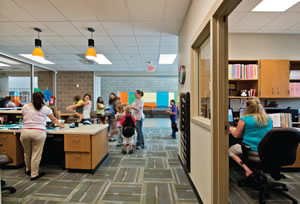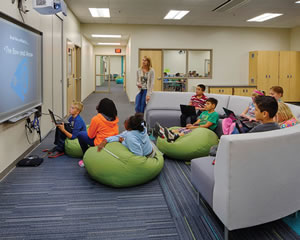Facilities (Learning Spaces)
Acoustics Alert
- By Michael Fickes
- May 1st, 2015

PHOTO COURTESY OF PERKINS+WILL
In the Monty Python movie “Life of Brian,” a scene shows a crowd listening as Jesus delivers the Sermon on the Mount. The camera moves back over the crowd to the back where no one can hear anything of the Beatitudes. They call out to the people just in front of them asking what is being said. They can barely hear, and they are not getting it quite right. Suddenly someone turns around and reports that Jesus just said: “Blessed are the cheesemakers.”
“So this magnificent lesson, one of the great lessons of history was lost to the people in the back rows because they couldn’t hear it,” says David Lubman, an acoustics consultant based in Westminster, Calif., who enjoys telling that story when discussing the importance of good acoustics to learning in schools.
Numerous studies have shown that excessive background noise and reverberation make it difficult to hear. In schools, the problem can prevent teachers from communicating and also prevent students with normal hearing from learning. It can lead to disastrous problems for students with impaired hearing.
Research also indicates that poor acoustics can lead teachers to raise their voices, which can strain vocal cords and create medical issues.
Background noise comes from the mechanical systems or from traffic and outdoor noise in schools where the windows must open to provide ventilation. It can also come from footsteps and scraping chairs on the floor above.
Reverberation is the length of time a sound lasts in a room. That may sound strange, but sounds reverberate or bounce off of surfaces in a room a number of times before subsiding. The length of these sounds can be measured.
Many have dismissed the idea of designing classrooms to recommended acoustical standards as a non-problem. But it is a problem.
In 2010, the Technical Committee on Architectural Acoustics of the Acoustical Society of America issued a paper entitled “Classroom Acoustics” that states: “In many classrooms in the United States, the speech intelligibility rating is 75 percent or less. That means that, in speech intelligibility tests, listeners with normal hearing can understand only 75 percent of the words read from a list. Imagine reading a textbook with every fourth word missing and being expected to understand the material and be tested on it. Sounds ridiculous? Well, that is exactly the situation facing students every day in schools all across the country.”

PHOTO COURTESY OF SHW GROUP
Hear Me Now? Factors like background noise, reverberation and the quieter speech of some teachers makes good acoustical design a critical component of everyday learning in the classroom and especially alternative learning spaces.
Background noise and reverberation are the cause.
Background noise
Lubman says that school ventilation systems typically generate 50 decibels of background noise and present a distinct challenge to students trying to understand what teachers are saying. That’s especially true of students sitting in the back of the room as well as those who are hearing impaired.
“For many years, educators didn’t understand the problem,” continues Lubman. “In the late 1990s, an acoustical consultant told me and others that background noise in classrooms had to be limited to 35 decibels for students to hear properly.
“I was not persuaded. Later, however, I came across a book called ‘Acoustical Designing in Architecture’ by Vern Knudsen and Cyril Harris, two educators, architectural acousticians and past president of the Acoustical Society of America.
“The book said that the desired level of background noise in a classroom should not exceed 35 decibels. Thirty-five decibels is the background noise level in a quiet bedroom.”
For the sake of contrast, a whisper is about 15 decibels and normal conversation is around 60 decibels.
Unaccountably, “Acoustical Designing in Architecture” was written 1929. In other words, this information about classroom acoustical levels has been available for debate, testing and scrutiny for 86 years.
It’s also important to remember that not all students are equal in hearing ability, says Lubman. Some have hearing impairments, which means that the 35-decibel limit on background noise isn’t good enough for them. When these children perform poorly, they are placed in special education classes, probably ensuring that they cannot live up to their potential.
“We want to design classrooms with very quiet background and sound levels,” says Rose Mary Su, senior consultant in acoustics at Acentech, an acoustics consulting firm with offices in Boston and Los Angeles.
“We want the HVAC system to run quietly and to avoid noise intrusion from adjacent rooms,” Su continues. “If you have classrooms stacked on top of each other, you have to pay attention to the construction sandwich to prevent footfall noise from above.”
Then there is reverberation — an echo that lasts for a period of time. When you yell in a canyon, the echo or reverberation might last for a number of seconds. In a classroom, reverberation and reverberation time might be difficult to perceive. Even so, it is there, and it can be measured.
“We measure reverberation by generating impulse sounds — like a balloon popping,” says Su.
Shushing the classroom
Acoustical school and classroom design aims to minimize background noise and reverberation.
Design and construction techniques include isolating the mechanical system, which is now possible thanks to central heating and air conditioning.
Designers and contractors must also control sound bouncing off of floors, walls and ceilings by choosing the right materials to reduce reverberation.
“In most standard classrooms, we use acoustical panels, which are being redesigned to make them larger and more absorbent,” Su says. “In some cases, the panels are becoming more dense to help insulate against noise coming through the ceiling from the room above.”
Often it is a balancing act between absorbing sound from below and reflecting sound from above with ceiling tiles doing both tasks. “These materials are becoming very sophisticated,” notes Su.
Following the ANSI Standard
Schools have always paid some attention to acoustical problems. But few were very scientific about it until 2002, when the American National Standard Institute (ANSI) issued “ANSI/ASA S12.60: Acoustical Performance Criteria, Design Requirements and Guidelines for Schools.”
The standard comes in two parts. Part I covers permanent schools and Part II covers temporary schools and trailers.
Both parts were revised in 2010. “The ANSI standard covers reverberation time and sound transmission class (STC), which is sound isolation,” says Su. “It also gives an acoustical rating for the floor: impact insulation class (IIC). This has to do with footfalls, chair scraping — noises that you don’t want to hear above you.
“Finally, the standard considers noise from the mechanical system and how that contributes to overall sound.”
LEED for Schools mentions the ANSI standard and recommends meeting the standard’s requirements for controlling reverberation time, sound transmission and background noise.

PHOTO COURTESY OF ATS&R PLANNERS/ARCHITECTS/ENGINEERS
Now comes the flipped classroom
As more and more teachers and schools adopt the concept of flipping the classroom, new acoustical and noise challenges are arising. As you may know, in a flipped classroom students do what used to be homework problems in class and listen to and watch lectures and presentations on the computer at home in the evening.
The idea is that students need the teacher the most when they first try to apply the principles communicated by the lecture or presentation. So a flipped classroom typically breaks up into groups of students and some students working alone on problems related to the lecture watched last night.
The teacher moves from group to group, answering questions and asking questions to gauge comprehension.
“Educators love group learning but they haven’t completely examined the consequences,” observes Lubman. “A useful conversation at one table in a flipped classroom becomes a distraction at another table.
“Educators have responded to me about this saying that it may be a good thing — students may overhear a new idea. Still there is a difference in listening ability among students, and you must take that into account.”
A flipped classroom doesn’t change the basic ANSI acoustical standard, adds Su. “It is certainly more challenging to design flipped classrooms with moveable walls,” she says. “If you are trying to meet sound isolation requirements, it can be expensive and difficult.”
Both Lubman and Su observe that we learned during the open-plan classroom movement of years ago that open classrooms are bad ideas.
“Today, there are common areas outside the classrooms,” says Su. “The key is to provide sound isolation between the classroom spaces along with options that teachers can use to separate students.
“I do worry about trying to design too much flexibility into classrooms and compromising the sound isolation, which is important at the ceiling and along the walls.”
Lubman adds that flipped classrooms should probably have fewer students. Fewer students can work in groups that are further apart. With fewer people speaking, the noise level in the room will automatically decline.
Lubman and Su and others that have studied classroom acoustics have been promoting the importance of adequate acoustical design for many years. Now with an ANSI Standard and LEED guidelines on classroom acoustics, the requirements are being formalized and probably applied more often.
In other words, they are finally being heard.
This article originally appeared in the May 2015 issue of School Planning & Management.